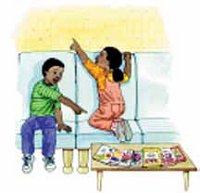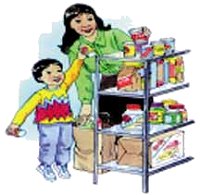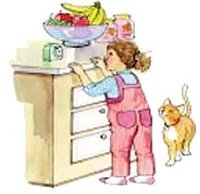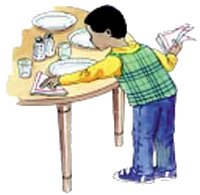|
Activities for Your Day
Waiting at the Doctor's Office or Other Places
Marcus and Keisha dreaded being at the dentist's office. To pass the time, Gram asked them to look for things that repeated. Keisha said, "Look at my shirt. It has a red stripe, a blue stripe, and then another red and another blue." Marcus found patterns in the rug and in the wallpaper. Since they were still waiting, they looked around the room and found patterns everywhere-the way the magazines were put on the table, the way the lights were put on the walls, and even the way the tiles were placed in the ceiling.

- Look for patterns-anything that repeats on the rug, on the wallpaper, or on the furniture. Patterns are on clothes, too. Describe the pattern: "It has blue stripes followed by white space and then another blue stripe..."
- Ask your children to use their fingers to trace the patterns you find on the chair or your clothes. They don't have to be able to draw. Tracing with their fingers helps children understand shapes and they love the sense of connecting and exploring.
- To help children pass time waiting, ask how many people are ahead of you and then subtract one or count down as patients are seen. Count how many are left waiting.
- Read books that rhyme, repeat, or have numbers in them. Count the animals, flowers, or trees throughout the book. Name the colors or shapes you see and then count all of those with one color.
- Keep counting! Count anything and everything! Counting is one of the best and easiest ways to introduce your children to mathematics. Young children can't always count accurately-- they make mistakes like counting the same object more than once. Don't worry about mistakes. Instead, take the child's finger and point to, or touch, the object as you both count.
- You can play a game of remembering with older children. Draw shapes on paper. Then, flip the paper over and see if your children can draw, trace in the air, or describe to you, the shape they just saw. Don't worry if they can't remember. As you do this activity again, they will begin to develop strategies for remembering shapes and numbers.
- Younger children can play with puzzles and older children will enjoy games that involve shapes in different positions or patterns. These are great "hands-on" activities that help children understand spatial concepts.
- For older children, make pieces of paper that get progressively larger and put numbers on them that get larger as the paper size increases. Ask children to place the piece of paper in order. The size of the paper and numbers allow them to use either their knowledge of numbers, or the relationship of size and helps children associate the larger numbers with larger size.
 At the Grocery Store
At the Grocery Store
As Dad picked the can of soup off of the shelf, he asked Jamal, "What shape is this can?" Jamal replied, "A circle!" "Very good, Jamal." The shape of the whole can is actually called a cylinder, but Dad was happy that Jamal was recognizing the shapes on the bottom of the can.
- Ask your children to find circle shapes on the can of soup or the square on the box of rice. Play a game in which you look for other items that are the same shape as you go through the store. It will help young children begin to recognize, identify, and describe shapes, a skill which will help them better understand geometry.
- Younger children can understand that the managers of the store have sorted items by type and placed them together in aisles. For older children, point out that each aisle has a number. Let your children help you find an aisle by its number or find in which aisle a particular item can be found. Some children love to count off the aisle numbers as they go through the store.
- Talk about the items as you place them in the basket. "Here's our cereal. Wow, this box is a big yellow rectangle. Now we have three boxes in the basket."
- Count oranges, apples, or eggs with your children.
- Show your children where to find the price of items. Read the amounts out loud. Point out that some numbers are bigger than others; some containers are bigger than others, and some items are more expensive than others. At checkout, read the numbers out loud as they appear on the screen.
- Before you put away the groceries, let your children sort them into piles such as cans and boxes, in the refrigerator or on the shelf. Finally, have them sort the groceries however you want them to be put away!
 In the Kitchen
In the Kitchen
Kaitlyn and Kevin were racing around in the kitchen while Mommy was getting dinner ready. "Kaitlyn, why don't you see if you can fit these pots and pans together for me," said Mommy. "And Kevin, I need a 1/4 teaspoon of salt. Can you find the measuring spoon for me?" Soon, everyone was busy and dinner was cooking.
- Young children enjoy playing with empty plastic food containers or pots and pans. Encourage them to stack them on top of or inside of each other. Many children will stay busy for a long time as they touch and handle objects, learning shapes, size, and relationships.
- Tell your children how many minutes the dinner needs to be in the oven. Close to the end, encourage them to watch the final minutes count down on the timer or the microwave and count the last ones together. Children love to count down with the timer and this is good practice.
- When making dinner, ask your children what shape baking dish you should use and why. Would the food fit in a dish that is another shape, too?
- Most children love to help you bake. Let them help put together the ingredients as you read out loud the amount. "We need a cup of flour. Can you find the measuring cups for me?" Older children can help you measure some of the less messy ingredients. Cooking is a great way for children to learn about sequences. "First we put in the flour, then we add the eggs..."
- Cooking provides a good opportunity for children to learn fractions. When making something with dough, cut off a piece and give it to your children using words like half, quarter, and tenth. For example, "Let me give you children half of the dough to make your own cookies. I'll give Shawndra a quarter of the dough, and Raymond the other quarter."
- When you are making rice for dinner, pour uncooked rice or water into a tall, thin container. Then pour the rice or water into a short, fat container after guessing whether or not it will spill over or look less full than the tall container. Things that are obvious to adults are not obvious to children and are often hard to explain. This game is a fun activity for letting children find out about quantity.
 Meal Time
Meal Time
Mama asked Maria to help set the table for dinner. "Let's count as we go," said Mama. When Maria was done, she proudly exclaimed, "I put 4 napkins and 4 spoons on the table!" Mama pointed out that the place settings follow a pattern: they all have 1 fork, 1 cup, 1 napkin, and 1 spoon in the same place.
- Ask your children to help set the table. Show them how you want the table set-the pattern of plate, cup, and silverware-and ask them to repeat that pattern for each person. Some children will count out the napkins, knives, forks, spoons, and plates as they take them to the table. Others may set the table one piece at a time. Let them develop their own strategy for getting the table set. Their strategy may evolve over time.
- To make eating more fun, cut your children's food into different shapes. Cut scrambled eggs into triangles, or sandwiches and fruit into circles or squares. Don't limit yourself to simple shapes, but use your imagination and create different designs. You might enjoy having a theme for a day. Serve round foods like crackers, cookies, or tortillas for a snack. Mention that all of the snacks are round. Do the same with foods of other shapes or use pasta that comes in shapes, including letters and numbers.
- When you buy your children a bag of candy or raisins ask them to estimate how many pieces are in the bag. Dump them onto a napkin and count to see if there are more than, less than, or the same as the amount they estimated. If possible, sort the candy by color or shape. Don't forget to count the pieces as they eat them. Keep track of how many a child has eaten and how many are left to eat. "Here are 5 raisins. When you eat 1, you have 1, 2, 3, 4 left. Eat another 1. So you now ate 2. How many are left?"
- Share a banana, sandwich, or cookie by splitting it into two parts of the same size. Explain to your child that each of you is eating one-half. You also can share four cookies between the two of you and explain that, once again, you each are eating one-half of the original amount. This connects the language for fractions with the concept.
- For an older child you might cut some treat in half and then cut one of the two pieces in half again so that you wind up with two quarter pieces and one half. Ask your child to take one piece and then ask why he or she chose that piece.
- Let your children help you divide dinner or dessert into equal parts for each member of your family. First explain the problem: how can everyone get a fair share? Ask them to help you work this out.
- You can extend the idea of cutting a cake or pizza into shares. Talk with your children to find out how many shares you can get from a whole pizza or cake and what size the shares will be. Children will see that as more people share, the size of the shares gets smaller.
- Children can use mealtime to understand the relationships within and between shapes. Cut your children's sandwich diagonally to make 2 triangles, up and down to make 2 rectangles, or in 4 parts to make 4 squares. Ask your children to name the shape and experiment with putting them back together.
- Give your children a calendar and ask them to keep track of how many times each week they ate their favorite food. They can mark the calendar with any kind of notation they make up themselves.
Math Activities for Ages Two to Five:
|
|
|